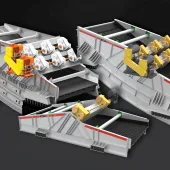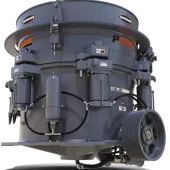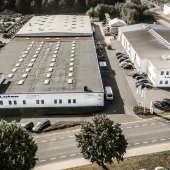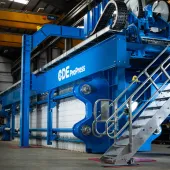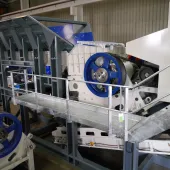Key Elements of Peppertree Quarry's Sandvik Processing Plant
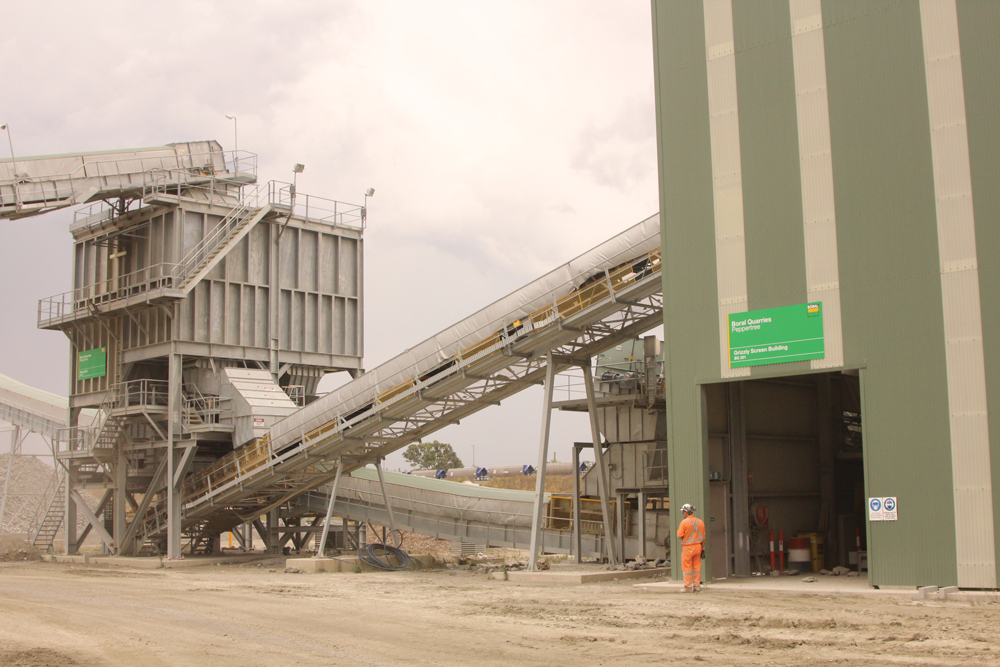
First published in the September 2016 issue of Quarry Management as part of Generational Investment at Peppertree.
Peppertree Quarry operates using a total of 3.4km of enclosed Sandvik belt conveyors. Aside from the primary stockpile from the quarry itself, an out-of-spec materials stockpile and scalpings stockpiles, all products are processed, handled and stored in an enclosed system until they are loaded into four daily trains to Sydney. The following provides an overview of the process from the quarry pit to the train loader.
A Sandvik conveyor with a capacity of 1,200 tonnes/h delivers material from the primary in-pit crusher to a Sandvik-supplied surge bin. This bin feeds the material to a primary screening station consisting of an SG2451 grizzly screen and an SC3062 circular-motion screen to remove any 0–25mm stone, before the material is fed to the primary stockpile.
Crusher building
The first stop for the primary stockpile material is the crusher building, where all secondary and tertiary crushing takes place.
Secondary crushing is carried out using a CS660 cone crusher with a maximum capacity of 750 tonnes/h, which outputs –100mm material. While material from this crusher can be used for 30–50mm railway ballast, the vast majority of its output is fed to a CH660 crusher to produce 0–60mm material.
Material in the range 0–2mm goes directly to the sand circuit, with the remainder feeding two CH440 tertiary cone crushers – also housed in the crusher building. These crushers break material into six fractions, which are re-crushed and/or blended to provide materials to meet any customer specification.
All these crushers feature Sandvik’s ASRi system, which provides automated crusher control as well as protecting them from damaging overloads. Sandvik ASRi also has the ability to communicate with other control systems. Additional benefits of this system included increased production, the highest possible degree of reduction, improved product distribution and better product shape.
Total capacity from this main crusher building is 550 tonnes/h of material – across all product size ranges.
Screen building
All material from the secondary and tertiary crushers comes through this building, where five of the latest-generation Sandvik SC3063 and SC2473 screens are used to screen material for delivery to the storage silos or back to the crusher building for additional processing and then re-screening.
The SC3063 screens are 3m wide by 6m long, while the SC2473 is 2.4m wide by 7m long; each has different deck types depending on the materials required.
Belt feeders below the screens operate fully automatically, giving a high degree of flexibility and allowing the production of a wide range of different products depending on market requirements.
Material produced in the screen building includes 2–4mm, 4–6mm, 6–10mm, 10–14mm and 14–20mm aggregates, as well as the 0–4mm fines fractions used for manufactured sands.
VSI crusher building
A separate building houses two CV128 vertical-shaft impactor (VSI) quaternary crushers.
These are primarily used for the final processing of the 0–4mm fines fractions for the site’s manufactured sand product, and have an output capacity of 190 tonnes/h of final product.
In addition, one of the VSIs can be used to ‘shape’ 10–20mm aggregate if required by market demands; this process is managed automatically through the site’s split online control system.
Air classifier
Two Sandvik air-classifier units reduce fines from the material coming out of the VSI crusher to between 4% and 6%. The air classifiers work on a cyclone principle to extract the fines – for which Boral are currently exploring market opportunities.
Storage silos
The eight stainless steel storage silos – the most distinctive element of Peppertree Quarry – hold all the ‘ingredients’ to make up the multiple product mixes Boral supply to their customers. The silos, which have varying capacities, each hold a specific material size which can be blended into various mixes according to customer requirements.
Each silo is constructed above the ground, with a bed feeding conveyor running beneath all eight silos at ground level, eliminating the need for tunnels and confined spaces to access the conveyor for maintenance or repairs. Openings beneath each silo allow them to be emptied using a wheel loader in the event of a silo being contaminated with oversized or badly shaped material, or to carry out maintenance inside the silo.
Cameras mounted within the conveyors feeding the silos continuously monitor the size and quality of the incoming material.
Bringing it all together
The final product mixes for transporting to Sydney are blended ‘on the fly’ as the materials are fed from the silos on to the conveyor in the required proportions.
The conveyor under the silos moves at a fixed rate, with product metered according to required recipes; by the time the material has gone through two transfer points, including a surge bin, and is fed into the train wagons, it is thoroughly mixed. This ‘on-the-fly’ blending system allows a larger range of material blends to be mixed and checked on site before transport.
Peppertree’s wide range and flexibility of product blends gives the plant a highly competitive advantage for servicing customers’ needs.
The final product mixes coming out of the silos to the train-loading systems are continually analysed through a sampling system located between the silos and the surge bin feeding the trains. This identifies any out-of-spec coarse aggregates and diverts them to a reject stockpile, from where they can be recirculated back into the processing plant.
Material from the train-loading surge bin can be loaded at up to 4,000 tonnes/h, allowing the loading of a 34-wagon train (each wagon holding 77 tonnes) in approximately 84 minutes.
Safety issues
Safety was the key consideration in developing the Peppertree operation, and the site features a number of innovative solutions to plant safety issues, including:
- Minimal ladders around the site; and steps with handrails
- Separate platforms for high-maintenance elements, such as oil tanks for the crushers
- Widespread use of fully encapsulated guarding, plus chain system for gravity-tensioning units on conveyors
- Minimal requirements for mobile plant around the site in day-to-day production
- No underground tunnels, for safer and easier maintenance
- Minimal confined-space areas.
Quality-control issues
To run the plant fully automatically, it incorporates a continuous quality-control system. This ensures, for example, that final products going into the silos are the correct size, that the aggregated product mixes being delivered to the train-loading system meet specifications, or that materials can be diverted to the VSI crushers for final shaping if required.
Cameras are located in all conveyors feeding the storage silos, with automatic shutdown of silo feeding if any out-of-spec material is identified. Belt feeders and bypass chutes below all screens have been designed to minimize the need for material rehandling and re-crushing.
Level sensors located at the top of the end-product silos indicate any silos filling up too fast for current delivery requirements, allowing the system to automatically reduce materials going to those silos.
During train loading, a sampling house takes samples directly from the belt to ensure all products are to the correct specifications.
This automated system was developed jointly by Sandvik and Boral and engineered by Melbourne-based Gordyn & Palmer. It incorporates detailed reporting systems and offers a high degree of flexibility to handle the full range of materials coming from the pit – allowing Boral to use Sandvik’s ASRi control systems to adjust the plant process to produce a wide range of different product ‘recipes’.
All of this combines to give Boral the ability to run the plant with a small number of operators per shift.
- Subscribe to Quarry Management, the monthly journal for the mineral products industry, to read articles before they appear on Agg-Net.com


